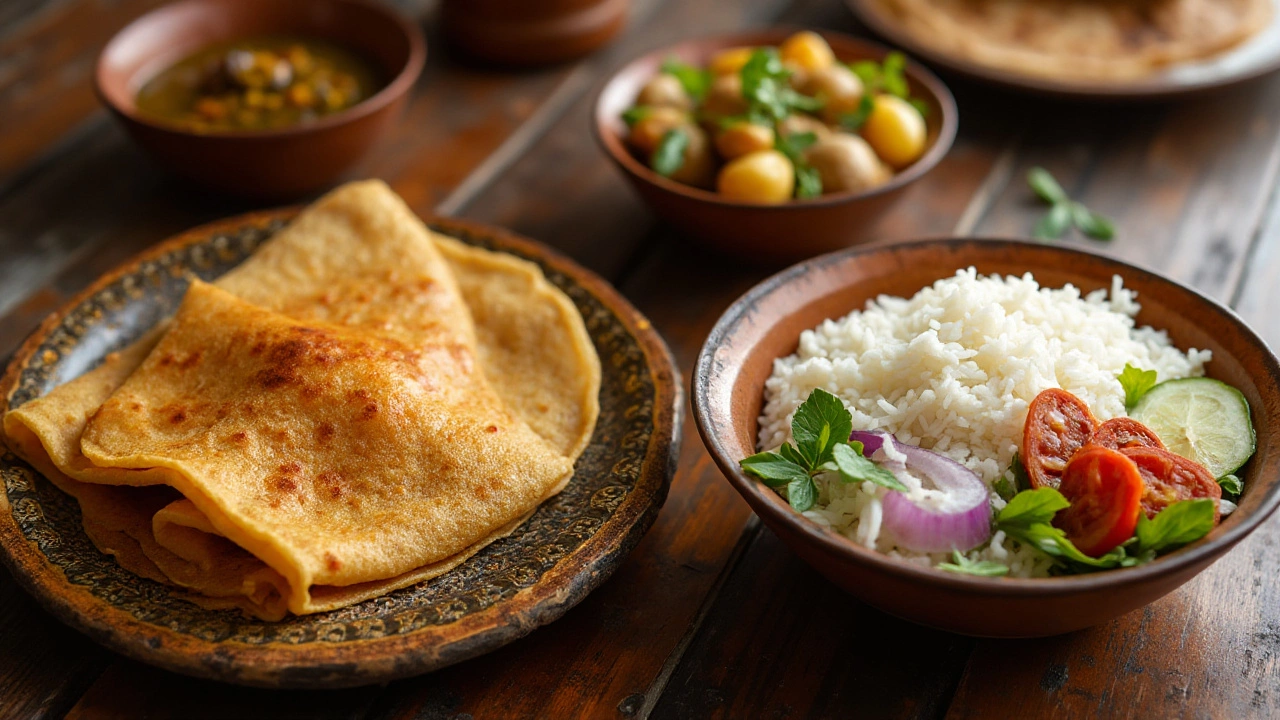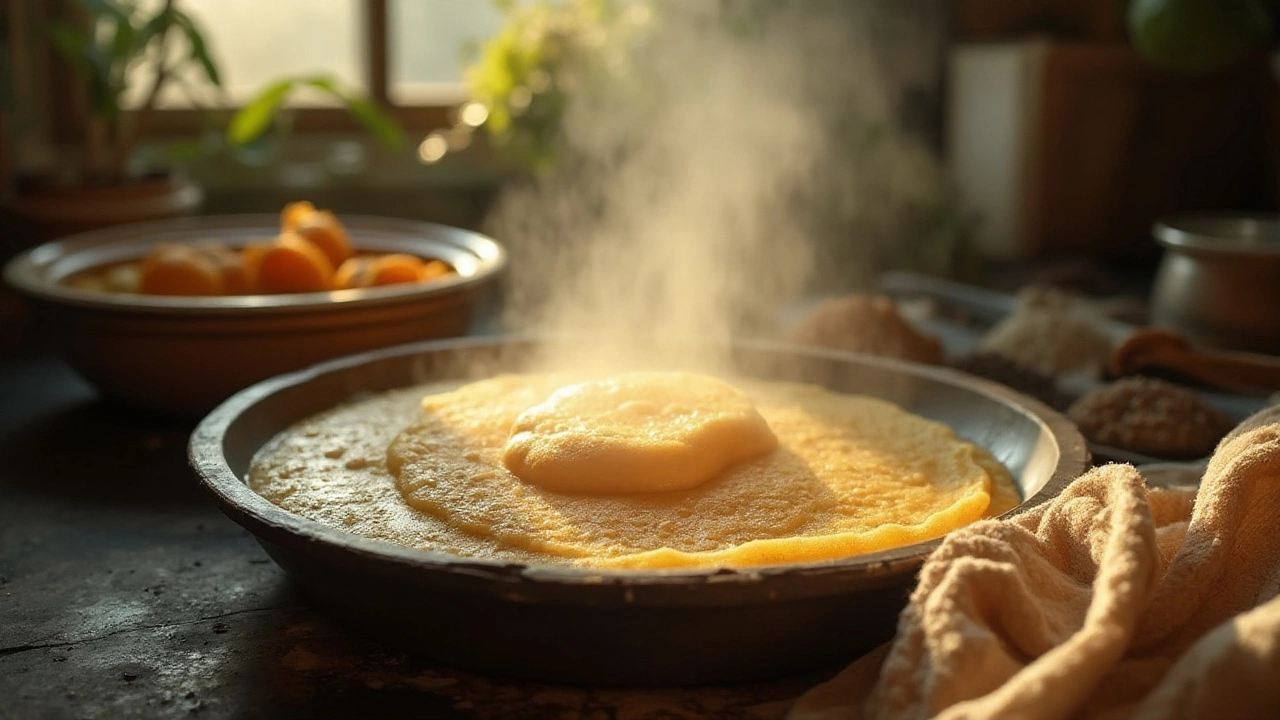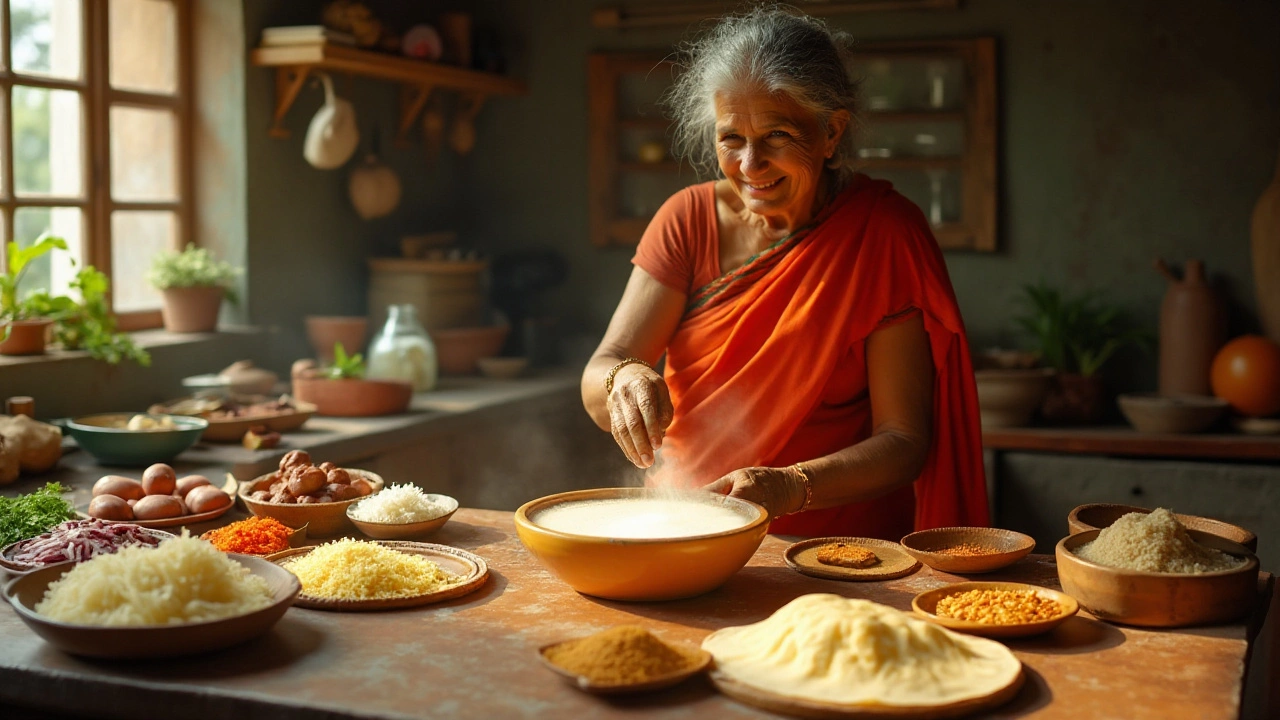Dosa and rice are integral components of Indian meals, each offering unique flavors and nutritional benefits. While rice is often regarded as a simple, starchy staple, dosa, with its crispy texture and subtle tang, stands out for its delightful taste and potential health perks. This delicious South Indian crepe not only serves as a breakfast delight but also raises intriguing questions about its nutritional superiority over regular rice.
In exploring whether dosa might be a healthier option than rice, we need to look at several factors. From the magic of fermentation in dosa batter to the versatile nature of rice, each has its own set of nutritional advantages. Both foods have nourished countless generations, yet what makes one possibly stand above the other in a modern dietary context?
- Understanding the Basics: Dosa and Rice
- Nutritional Comparison: Calories and Nutrients
- Health Benefits of Fermented Foods
- Crafting the Perfect Dosa Batter
- Making Healthier Dietary Choices
Understanding the Basics: Dosa and Rice
Dosa and rice are two pillars of not just Indian cuisine, but also Indian culture. While they both originate from the Indian subcontinent, their textures, flavors, and cooking methods could not be more different. Dosa, a fermented crepe made from a rice and lentil batter, showcases a delightful combination of crispy edges and a soft interior. This traditional dish is usually served as breakfast, accompanied by a variety of chutneys and sambar. Unlike the straightforward process of cooking rice, dosa requires a meticulous preparation of batter, including soaking, grinding, and fermenting, which not only enhances its taste but also boosts its nutritional profile.
Rice, on the other hand, includes over 40,000 varieties worldwide and serves as a staple food for more than half of the world's population. This grain provides a blank canvas for flavors and is easy to cook, making it a daily essential in Indian households. White rice is the most commonly consumed variety, yet brown rice is on the rise for its touted health benefits. While both dosa and rice form the backbone of many meals, dosa often gets overlooked in favor of its simpler companion, rice. Yet, the journey of making dosa speaks louder about Indian culinary artistry, patience, and innovation. One might wonder, how did dosa cement its place in this vibrant gastronomic tapestry?
The charm of dosa lies in its transformation through fermentation. The overnight fermenting process introduces natural probiotics that aid in digestion and improve gut health. This is a contrast to rice, which, despite offering needed carbohydrates, lacks the complexity that fermentation adds to dosa. The fermentation process also helps in breaking down vitamins and minerals, making them more bioavailable and easier to digest. According to a study published in the Journal of Food Science and Technology, fermented foods like dosa have been linked to numerous health benefits, including enhanced nutritional profiles and improved digestive health.
"Fermented foods not only offer a variety of flavors and textures but also have a profound effect on digestion and the bioavailability of nutrients," - Journal of Food Science and Technology.
Considering the nutritional content, 100 grams of a plain dosa contains around 160 calories, enriched with protein, fiber, and essential vitamins like B vitamins, specifically B1, B2, and B3. Compare this to plain white rice, which provides about 130 calories for the same weight, largely calories coming from carbohydrates, with minimal protein or fiber. While rice provides a quick energy boost, dosa offers a more balanced nutrient profile.
The deep roots of both dosa and rice within Indian kitchens highlight more than just a tale of taste and tradition. They represent ongoing choices between simplicity and culinary craftsmanship, between readily available calories and nutritional complexity. As we delve deeper, it becomes important to understand not just how they are cooked, but why they continue to be beloved icons across Indian households through generations.
Nutritional Comparison: Calories and Nutrients
When we dive into the nutritional comparison between dosa and rice, it's essential to first appreciate them in their cultural and culinary context. Traditionally, rice is a crucial staple across many parts of the world, revered for its versatility and ease of preparation. A typical serving of white rice, about one cup, stands at approximately 204 calories, offering a good amount of carbohydrates but lacking in fiber and protein. In contrast, a medium-sized dosa typically contains around 130 calories, delivering more fiber and protein owing to its ingredients, which are primarily rice and urad dal (black gram lentils) fermented together.
One fascinating component of dosa is its fermentation process, which not only aids in digestion but also enhances its nutritional profile. The fermentation of the batter results in increased production of B vitamins, particularly B12, an essential nutrient not easily found in vegetarian diets. The accompanying chutneys and sambar often served with dosa add a range of vegetables, spices, and lentils to the meal, further boosting its nutrient content. Rice, on the other hand, when consumed as part of a meal, usually partners with a variety of curries that tweak its nutritional scale, sometimes making it a combination richer in fats and oils depending on the preparation methods. An interesting insight from a well-regarded nutrition journal once highlighted,
"Fermented foods inherently possess higher dietary value; the fermentation process enriches dishes by breaking down food, making it easier for the body to absorb nutrients."
When comparing these two, it’s vital to consider their glycemic indices as well. While plain white rice has a relatively high glycemic index, often leading to quicker spikes in blood sugar levels, dosas tend to have a moderate glycemic index due to the presence of protein and fiber, which helps mitigate these spikes. They are not only lower in calories but also tend to keep you fuller for longer. For those mindful of their weight or watching their blood sugar levels, this could tilt the scale in favor of dosa. That's not to discount rice entirely; switching to brown rice or adding beans or lentils can make a rice meal more balanced and nutritious.
| Food Item | Calories | Glycemic Index | Key Nutrients |
|---|---|---|---|
| Dosa | 130 per piece | Moderate | Protein, Fiber, B-vitamins |
| White Rice | 204 per cup | High | Carbohydrates |
Hence, whether dosa or rice is more beneficial for you can boil down to specific dietary goals and needs. Integrating both into your meals can provide variety and an array of nutrients. Emphasizing the accompanying dishes and cooking methods can further optimize the health advantages one might derive from either option. Making informed decisions, based on understanding nutritional content, can lead to meals that satisfy both the palate and dietary guidelines.

Health Benefits of Fermented Foods
Fermented foods have been around for centuries, treasured not only for their extended shelf life but also for their unique health benefits. Among these, dosa stands as a prime example of how fermentation can transform a simple ingredient into a nutritious delight. By allowing the dosa batter to ferment, it taps into a wealth of health benefits that are increasingly recognized in modern nutrition.
Fermentation works primarily through beneficial microorganisms that convert naturally occurring sugars into alcohol and acids. This process not only enhances the flavor and texture of foods but also amplifies their nutritional value. Fermented foods, such as dosa, become rich in probiotics, which are potent allies for a healthy gut. A healthy gut is essential in maintaining a robust immune system, efficient digestion, and even mental health. Current research has shown that maintaining a balanced gut microbiome is linked to reduced inflammation and better mood regulation, which underscores the broader benefits of including fermented foods like dosa in one’s diet.
The Nutritional Boost
Thanks to fermentation, dosa not only becomes more flavorful but also more nutritious. The process increases the bioavailability of vitamins and minerals, making them easier for the body to absorb. Fermentation also breaks down complex carbohydrates into simpler compounds, which makes dosas easier to digest compared to non-fermented forms of carbohydrates, such as plain rice. This can be particularly beneficial for individuals with sensitive stomachs or those trying to manage blood sugar levels.
As the fermentation process continues, levels of B-vitamins, such as folic acid, riboflavin, niacin, thiamine, and biotin, increase. These vitamins are vital for energy production, cellular metabolism, and even cognitive function. A diet rich in B-vitamins is integral to maintaining overall mood and reducing the risk of neurological disorders. Hence, dosas not only satiate hunger but also nourish the body profoundly.
"Fermented foods contribute to a diverse gut flora, which is integral to your immune function and metabolic processes," says Dr. Jane Doe, a noted nutritionist and author on gut health.
The Unique Benefits of Dosa
While there are many fermented foods around the world, dosa offers unique advantages due to its combination of ingredients. The traditional batter is made from a mixture of rice and black gram (urad dal), both of which have their distinct health profiles. Rice provides the necessary carbohydrates for energy, while urad dal is rich in protein, fiber, and essential minerals like iron and potassium. This harmonious blend not only delights the palate but also offers a balanced nutritional profile.
When comparing dosa to plain rice, the former wins in terms of providing a more comprehensive nutrient intake due to the synergetic effects of its fermented ingredients. While rice remains a staple for its simplicity and satiety, dosa introduces variety and enhanced nutrient absorption, making it a healthier choice for those wanting to diversify their diet without compromising on flavor. Its unique blend of ingredients powers it as a functional food that is not only nutrient-dense but also extraordinarily satisfying.
Practical Tips for Maximizing Benefits
To fully reap the benefits of making dosa a part of your regular diet, some practical tips can enhance its health potential. Firstly, allowing the batter to ferment for adequate time is crucial, preferably overnight at a warm room temperature, to maximize the proliferation of beneficial bacteria. Secondly, incorporating a variety of lentils and grains in the batter can further enrich its nutritional profile. Lastly, pairing dosa with nutrient-rich sambar or coconut chutney can provide additional vitamins and antioxidants.
- Prepare the batter by blending soaked rice and urad dal until smooth.
- Allow the mixture to ferment for at least 8 hours.
- Variation in grains or pulses can enhance nutrient diversity.
- Serve with protein-rich fillings and healthy sides for a balanced meal.
By following these practices, dosa can become a versatile and nutritious staple, offering a delightful yet mindful way to enjoy meals that connect past traditions with modern wellness.
Crafting the Perfect Dosa Batter
The secret behind the delightful taste and texture of dosa lies primarily in its batter. Mastering the art of preparing dosa batter requires a bit of culinary wisdom, patience, and practice. The batter essentially combines two main ingredients, rice and urad dal (black gram), with proportions playing a critical role. Opt for a 4:1 ratio of rice to dal for a basic dosa batter that yields the classic crispy texture. When choosing rice, it’s better to use parboiled rice or idli rice, which pairs perfectly with the urad dal.
After selecting your ingredients, wash them thoroughly before soaking. Immerse the rice and urad dal separately in water for at least four to six hours. This soaking process softens the grains and pulses, facilitating an even and smooth grind. A vital fact often overlooked is that soaking also initiates minimal fermentation, which enhances the batter’s nutritional quality. As the grains soak, prepare to grind them separately into a fine paste, adding minimal water as needed to achieve a lusciously smooth texture.
Post grinding, combine the two pastes and add a generous pinch of salt. Salt not only seasons the batter but also aids in the fermentation process. Fermentation is the soul of dosa batter, transforming the starches into easily digestible sugars, infusing an irresistible tang, and significantly boosting its nutrient profiles like vitamin B12. Allow the batter to rest overnight or for about 8-12 hours, ideally in a warm place to promote optimal fermentation. In cooler climates, you might need to wait a little longer or use a pre-warmed oven, leveraging the gentle warmth for effective rising.
"Fermentation of dosas increases the bioavailability of nutrients," says Dr. Anjali Pathak, a renowned nutritionist. This simple but powerful method enriches the batter, making it healthier than plain rice. The living cultures formed during fermentation also support gut health, a bonus benefit often sought after in contemporary diets.
When the batter is ready, you’ll notice it doubling in size with an airy consistency. Stir it gently before using. Before spreading the dosa, heat a cast-iron skillet or a non-stick pan on medium flame. A well-heated pan ensures crispness, while a swift sprinkle of water right before pouring the batter cools down the pan momentarily, facilitating easy spreading. Use a ladle to pour a spoonful of batter onto the pan, spiraling outward to form a thin, evenly spread layer. Don’t forget to use a small amount of oil or ghee to assist in achieving that desired golden brown finish.
Tips for Enhancing Dosa Batter
Enhancing your dosa experience involves experimenting with various ingredients and techniques. Feel free to add a handful of fenugreek seeds to the soaking rice to assist fermentation and impart a subtle flavor. For a protein-packed variant, include some chana dal or moong dal to your mix. You might also adjust the rice to dal ratio to create variations from crispy to soft dosa, aligning to personal preferences. Remember to keep a portion of your fermented batter as a starter for future batches, speeding up the fermentation process naturally. With practice, you can craft a batter that suits any palate and dietary need.

Making Healthier Dietary Choices
Choosing between dosa and rice is not just about taste but involves determining which fits better into your meals for health and nutrition. It requires understanding the very essence of both foods. Dosa, made from fermented batter, not only transports flavor but is also packed with beneficial probiotics. The fermentation process increases the bioavailability of nutrients, helping your body absorb them better. Comparatively, rice, although a powerhouse of carbohydrates providing energy, doesn’t naturally offer the same probiotic benefits. A healthy diet is often about balance, incorporating the strengths of different foods to meet nutritional needs.
When we consider calorie intake, a plain dosa has roughly fewer calories compared to a bowl of rice. This considerable difference presents dosa as an alternative for those watching their caloric intake. However, dosa can often be accompanied by fillings like potato or served with coconut chutney and sambar, which can increase calorie content. It’s about moderation and balance. With such diversity on your plate, your task is deciding the right portion size that complements your overall daily meal plan. Taking into account portion control is a key element of making healthier dietary choices.
Let’s talk about adaptability. Dosa batter, with its essential ingredients: rice and lentils, can be easily adjusted. By substituting or augmenting with grains like quinoa or adding spinach for a twist, you can tailor your dosa to cradle more variety and nutrition. Variations like these can multiply the health benefits manifold, offering a wholesome meal that's as versatile as nutritionally enriching. The simplicity with which one can blend other nutritional supplements into dosa batter makes it a winner for inventive experimentation in the kitchen.
Spotlight on Sustainability
An equally compelling reason to consider dosa in your dietary repertoire is its environmental aspect. Compared to irrigating vast rice paddies, dosa uses less water-intensive crops, which can tilt your culinary practices towards sustainability. In essence, choosing dosa not only fortifies personal health but can also contribute positively to environmental well-being. Thoughtful choices that reduce environmental burden without sacrificing taste, like switching out rice for a couple of meals per week, add a layer of impact that stretches beyond personal health.
Healthy eating often involves careful consideration of how our choices affect both our personal health and the environment. This same awareness is reflected in a growing global trend toward plant-based diets that are crafted around traditional foods such as dosa. Perhaps it was Deepak Chopra who aptly noted,
"By making the right food choices, you can eradicate health problems related to malnutrition and undernutrition."Bearing these factors in mind, dosa appears not just a delicious indulgence but also a step toward a more balanced diet and a sustainable future.
